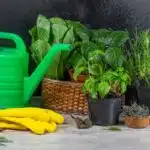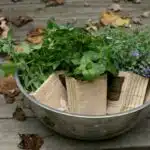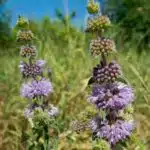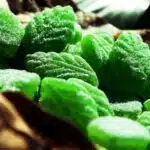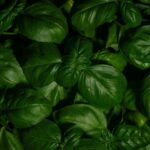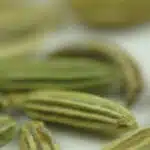For those who are new to gardening, growing herbs is an excellent way to start. Herbs are low maintenance, require minimal space, and can be grown indoors or outdoors. They also have the added benefit of being used in cooking, making them a practical addition to any kitchen.
In this article, we will explore ten easy-to-grow herbs that are perfect for beginners. We will discuss their unique characteristics, growing requirements, and culinary uses. Whether you want to add flavor to your meals or create a relaxing herbal tea blend, these herbs are sure to bring joy and satisfaction to your gardening journey.
Basil
Are you tired of spending a fortune on fresh herbs at the grocery store? Do you want to take your culinary skills to the next level? Look no further than basil! This herb is easy to grow and packs a punch in both flavor and health benefits.
Growing techniques for basil are simple, making it an ideal starter herb. It thrives in well-drained soil with plenty of sunlight and water. Basil can be grown indoors or outdoors, but it prefers warm temperatures between 70-90°F. Its delicate leaves can be harvested continuously throughout the growing season by pinching off the top leaf nodes.
Not only does basil add a fragrant aroma and taste to dishes, but it also has numerous health benefits. It contains antioxidants and anti-inflammatory properties that can boost immunity, reduce stress levels, and alleviate respiratory issues. Incorporating fresh basil into your diet can lead to improved overall wellness. So why not give this versatile herb a chance to enhance your lifestyle?
As we transition into discussing mint, keep in mind that growing herbs is not only beneficial for personal use but also as a way to serve others through sharing your harvest or creating homemade remedies.
Mint
Mint is one of the easiest herbs to grow and perfect for beginners. It is a perennial herb that thrives in moist soil with good drainage and partial shade. This aromatic herb has many uses beyond cooking, making it a versatile addition to any garden.
Uses for mint beyond cooking include its ability to repel insects naturally. Mint leaves can be infused in oil or water and used as a natural insect repellent or added to homemade cleaning products. Additionally, mint has been used medicinally for centuries for its soothing properties. Peppermint tea is known to help soothe upset stomachs, while spearmint tea can aid in digestion.
The benefits of mint for health extend beyond its medicinal uses. The aroma of mint has been shown to improve cognitive function and mood, making it a popular essential oil for aromatherapy. Mint also contains antioxidants and anti-inflammatory compounds that can help protect against chronic diseases such as cancer and heart disease.
Transition into subsequent section: If you’re looking for another easy-to-grow herb with numerous health benefits, look no further than rosemary.
Rosemary
Mint is a classic herb that many beginner gardeners start with due to its ease of growth and versatility in the kitchen. However, for those ready to expand their herbal repertoire, rosemary is an excellent next step. Rosemary is a woody perennial herb that is native to the Mediterranean region but has become widely popular worldwide.
One of the major benefits of growing rosemary is its flavorful and aromatic leaves. Its needles are a staple in many dishes and can be used fresh or dried. In addition, rosemary also has medicinal properties such as improving digestion, reducing stress levels, and enhancing memory function. These benefits make it an excellent addition to any home garden.
Creative uses for rosemary extend beyond just culinary or medicinal purposes. It can be used as a natural air freshener by boiling some sprigs in water or as decoration in wreaths or floral arrangements. Its strong aroma also makes it useful in deterring pests such as mosquitos and flies from outdoor areas.
Next on our list of easy herbs to grow is thyme. Thyme shares many similarities with rosemary, including being native to the Mediterranean region and having culinary and medicinal uses. Let’s explore more about this versatile herb in the following section.
Thyme
Thyme, a small herb with tiny leaves and a pungent aroma, is an excellent addition to any herb garden. It is one of the most versatile herbs that you can grow and can be used in a variety of dishes. Not only does it add flavor to your food, but thyme also has several benefits that make it worth growing.
One of the most popular uses for thyme is making tea. Thyme tea has many health benefits, including its ability to boost your immune system and reduce inflammation in the body. It is also known for its antiseptic properties and can help fight off infections. Thyme tea has been used as a natural remedy for coughs and sore throats for centuries.
Apart from being a tasty addition to your meals and beverages, thyme has many medicinal properties too. It contains essential oils that have anti-inflammatory and antioxidant properties, which make it an effective natural remedy for treating respiratory conditions such as bronchitis, asthma, and chest congestion. In addition to this, thyme oil can be used topically to treat skin infections or wounds.
As we have seen, thyme is not just a flavorful herb but also a beneficial one with various medicinal properties. Growing thyme in your garden will not only provide you with fresh herbs all year round but also allow you to enjoy its natural remedies at home! Next up on our list of easy-to-grow herbs is sage – another versatile herb that has numerous culinary uses.
Sage
Thyme is a versatile herb that can be grown both indoors and outdoors. However, if you are looking for another multipurpose herb to add to your collection, sage is an excellent choice. Sage is a perennial herb that has been used for centuries in cooking and alternative medicine.
Sage has several uses in alternative medicine. It is believed to have anti-inflammatory and antioxidant properties, making it useful in treating various ailments such as sore throats, coughs, and digestive issues. Additionally, sage tea is often used as a natural remedy for hot flashes and other menopausal symptoms.
If you want to grow your own sage plants, propagation is relatively easy. The best time to plant sage seeds is in the spring after the last frost has passed. You can also propagate sage by taking cuttings from an established plant and rooting them in water or soil. Sage prefers well-draining soil and full sun exposure, but it can tolerate some shade as well.
As we move on from discussing sage, another herb that is easy to grow and has a variety of culinary uses is oregano. Oregano is a hardy perennial that can be grown both indoors and outdoors, making it an excellent addition to any herb garden or windowsill planter.
Oregano
- Oregano is an easy herb to grow, making it an ideal choice for beginner gardeners.
- Oregano thrives in warm, sunny areas and needs well-draining soil to develop its full flavor.
- Oregano is a popular culinary herb, used to add flavor to sauces, salads and stews.
- It is also known for its medicinal properties, and is used to treat a number of conditions such as digestive issues and skin ailments.
Growing Oregano
Oregano is one of the most popular herbs used in cooking worldwide. It is known for its strong, earthy flavor and aroma, making it an excellent addition to a variety of dishes. Oregano propagation is relatively easy for beginners since the herb grows well both indoors and outdoors.
To grow oregano, start by selecting a sunny location with well-draining soil. The ideal soil pH range for oregano is between 6.0 to 8.0. Next, sow the seeds ¼ inch deep and water them regularly until they germinate in about 1-2 weeks. Alternatively, you can propagate oregano through stem cuttings taken from mature plants during spring or summer. Oregano requires minimal maintenance and can be harvested throughout the growing season.
Aside from its culinary applications, oregano has been used for medicinal purposes for centuries due to its anti-inflammatory and antimicrobial properties. It is also rich in antioxidants that help protect the body against cellular damage caused by free radicals. Overall, growing oregano is a great way to add flavor to your meals while enjoying its health benefits at the same time!
Using Oregano
Now that we have discussed the basics of growing oregano, let’s talk about using it. Oregano is not just a flavorful herb for cooking, but it also has medicinal benefits. Its anti-inflammatory and antimicrobial properties make it a popular natural remedy for coughs, colds, and sore throats. Oregano tea can soothe digestive issues such as bloating and indigestion. It is also said to have a calming effect on the body and mind.
Another way to use oregano is by making DIY oregano oil. Oregano oil is known for its antifungal and antibacterial properties, making it an effective natural alternative to commercial disinfectants. To make your own oregano oil, simply infuse dried oregano leaves in olive oil or another carrier oil for several weeks. You can then strain the mixture and store the oil in a dark glass bottle in a cool place.
In summary, using oregano goes beyond adding flavor to your meals – it can also provide numerous health benefits. Whether you prefer drinking oregano tea or making your own oregano oil, this versatile herb can be used in various ways to improve your well-being naturally.
Chives
Chives are a versatile and easy-to-grow herb that is perfect for beginners. With their mild onion flavor, chives can be used in a variety of dishes, from soups and salads to omelets and dips. They are also a great addition to any herb garden, adding texture and color with their long, slender leaves.
Growing tips for chives are simple and straightforward. These herbs prefer full sun but can tolerate some shade. They also prefer well-draining soil that is rich in organic matter. Chives can be grown from seed or purchased as small plants, making them an ideal choice for novice gardeners. To maintain healthy growth, be sure to water chives regularly and fertilize them every few weeks.
Culinary benefits of chives are numerous. Not only do they add flavor to dishes, but they also contain vitamins A and C, as well as iron and calcium. Chopped chives can be added to mashed potatoes or used as a topping for baked potatoes. They can also be used to garnish soups or salads, adding both flavor and visual interest.
Next up is parsley, another easy-to-grow herb with many culinary uses. Like chives, parsley prefers full sun but can tolerate some shade. Its delicate leaves make it an attractive addition to any garden or container. Stay tuned for growing tips and culinary benefits of this popular herb!
Parsley
Parsley is a versatile herb that can be grown in small spaces and offers numerous health benefits. It is an easy-to-grow plant that can be enjoyed year-round, making it a perfect addition to any herb garden.
One of the main benefits of parsley is its high nutritional value. Parsley is rich in vitamins A, C, and K, as well as minerals like iron and potassium. It also contains antioxidants that help protect against cell damage caused by free radicals, which can lead to chronic diseases.
Growing parsley in small spaces is easy with the right techniques. The herb thrives in well-drained soil with partial shade and requires consistent watering. To ensure a constant supply of fresh parsley, it’s recommended to plant new seeds every two weeks.
Next up on our list of easy-to-grow herbs is cilantro. This herb has a unique flavor profile and is commonly used in Mexican and Asian cuisines. Let’s explore the benefits of cilantro and how to grow it successfully in your own garden.
Cilantro
Continuing with our list of easy herbs to grow, we move on from parsley to cilantro. Like parsley, cilantro belongs to the Apiaceae family and is commonly used in many cuisines worldwide. This herb adds a unique flavor profile to dishes and has numerous health benefits.
Cilantro is known for its antioxidant properties and can aid in digestion while also promoting healthy skin. It contains essential oils that give it a distinctive aroma and flavor, making it an excellent addition to many recipes. Cultivating cilantro requires well-drained soil and full sun exposure. It can be grown in containers or directly in the ground.
Here are some popular cilantro recipes from around the world:
- Mexican: Salsa verde
- Indian: Cilantro chutney
- Thai: Tom yum soup
- Fusion: Cilantro lime rice
Incorporating cilantro into your cooking not only adds flavor but also provides health benefits. Growing this herb is relatively easy, making it perfect for beginners who want to try their hand at gardening. In the next section, we will explore another popular herb – dill – which also has a distinct taste and versatile uses in cooking.
Dill
Dill is an herb that evokes a sense of freshness and liveliness in the garden. Its delicate, fern-like leaves sway gently in the breeze, creating a soothing atmosphere for anyone who sees it. Dill is a versatile herb that can be used fresh or dried in many culinary dishes, but its most popular use is in pickling.
Using dill in pickling has been a common practice since ancient times. The unique flavor profile of dill enhances the taste of pickled vegetables and fruits, making them more flavorful and delicious. The essential oils found in dill seeds have antimicrobial properties that help preserve food for longer periods. Dill is also known to aid digestion and reduce inflammation.
Aside from its culinary uses, dill has medicinal properties that make it a valuable addition to any herbal medicine cabinet. It contains compounds such as carvone and limonene that act as antioxidants and anti-inflammatory agents. Dill tea can be used to alleviate bloating, gas, and stomach cramps caused by indigestion. It can also help soothe coughs and relieve menstrual cramps.
Incorporating dill into your herb garden is an excellent choice for both culinary and medicinal purposes. Its unique characteristics make it stand out among other herbs. In the subsequent section about the unique characteristics of each herb, we will explore how these herbs differ from one another while still retaining their beneficial qualities.
Unique Characteristics Of Each Herb
Each herb has its unique characteristics that make it an essential addition to any garden. Here are some of the unique features of each herb on our list:
Basil: This herb is known for its sweet aroma and delicate flavor. It pairs well with tomatoes, garlic, and mozzarella cheese, making it a staple in Italian cuisine. Basil also has medicinal benefits, such as reducing inflammation and improving digestion.
Chives: These onion-like herbs have a mild flavor that pairs well with potatoes, eggs, and soups. They also have medicinal benefits, such as lowering blood pressure and fighting against infections.
Cilantro: This herb has a pungent flavor and aroma that adds depth to Mexican dishes like salsa and guacamole. In addition to its culinary uses, cilantro also has medicinal benefits like aiding in digestion and reducing anxiety.
These herbs not only add flavor to your dishes but also provide tremendous health benefits. Herb pairing suggestions can help you create delicious meals while reaping the benefits of these plants’ medicinal properties. In the next section, we will discuss the growing requirements for each herb so you can get started on your own home garden today!
Growing Requirements For Each Herb
After learning about the unique characteristics of each herb, it is time to dive into the growing requirements for each one. Container gardening is a popular option for many beginners, especially those with limited space or those who want to bring their herbs indoors during colder months. When selecting a container, make sure it has drainage holes and is large enough for the herb’s root system to grow.
Soil preparation is crucial when it comes to growing herbs successfully. It is recommended to use a high-quality potting mix that contains peat moss, perlite or vermiculite, and compost. Herbs prefer well-draining soil that retains moisture but does not become waterlogged. Before planting, add some slow-release fertilizer to provide nutrients throughout the growing season.
Each herb has its own specific growing requirements, including sunlight, water needs, and temperature preferences. For example, basil thrives in full sun and needs consistent moisture while rosemary prefers well-drained soil and can tolerate drier conditions. Learning about these individual needs will help ensure that your herbs grow healthy and strong.
Moving on from soil preparation and container gardening, let’s explore the culinary uses of each herb. Understanding how to use these herbs in cooking will not only enhance your dishes’ flavors but also allow you to fully appreciate the benefits of growing your own herbs at home.
Culinary Uses Of Each Herb
The culinary uses of each herb are as varied as they are delightful. Just imagining the fragrant aroma of fresh herbs in your kitchen can bring a smile to your face. These easy-to-grow herbs do more than just add flavor and pizzazz to your dishes, they also offer numerous health benefits.
Here are some herb pairing suggestions that will take your cooking game to the next level:
- Basil: pairs well with tomatoes, mozzarella, and grilled veggies
- Mint: adds zing to fruit salads and cocktails
- Thyme: perfect for roasted meats and vegetables
- Rosemary: enhances the flavor of lamb, chicken, and potatoes
- Parsley: great in soups, stews, and salads
Using fresh herbs in cooking has many health benefits. For one thing, fresh herbs pack a bigger punch than dried ones. They contain higher levels of antioxidants and other nutrients that help fight disease. Additionally, using fresh herbs can cut down on the amount of salt and fat you use in your cooking. So not only do they taste great but they’re good for you too!
Incorporating these 10 easy-to-grow herbs into your culinary repertoire is sure to impress your family and friends. With all their health benefits and delicious flavor profiles, there’s no reason not to give them a try! But before you start planting them outside or indoors, check out our next section for some helpful tips on how to ensure their success.
Indoor Vs. Outdoor Growing Tips
Culinary enthusiasts know that there’s nothing more rewarding than cultivating your own herbs. However, not everyone has access to outdoor space or the right weather conditions for growing a garden. This is where indoor herb growing comes in handy. Indoor herb gardens can be grown year-round and provide fresh herbs for cooking without having to step outside.
When it comes to indoor herb growing, there are pros and cons to consider. On the plus side, you have complete control over the environment your plants grow in, which means you can customize the temperature, light exposure, and moisture levels to suit each herb’s individual needs. Additionally, you won’t have to worry about pests or harsh weather conditions damaging your plants. However, indoor herb gardening requires a bit more maintenance than outdoor gardening since you’ll need to simulate natural light and air circulation.
On the other hand, if you have access to outdoor space, growing herbs outdoors is generally easier and more cost-effective than indoor gardening. Outdoor gardens provide ample sunlight and natural air circulation that help plants thrive without any extra effort on your part. The best practices for outdoor herb gardening include choosing a sunny spot with well-draining soil, spacing out plants properly, providing adequate water and nutrients, and pruning regularly to encourage healthy growth. With these tips in mind, anyone can enjoy a flourishing outdoor herb garden all season long!
When it comes time to harvest your herbs, it’s important to do so at the right time of day when their oils are at their peak potency. For most herbs, this means harvesting in the morning after any dew has dried but before the sun gets too hot. Use sharp scissors or shears to snip off stems just above a pair of leaves; this will encourage new growth and keep your plant looking tidy. Once you’ve harvested your herbs, wash them thoroughly under running water before drying them completely (either by hanging them upside down or using a dehydrator). Properly dried herbs can be stored in airtight containers for up to a year, providing you with fresh herbs all year round!
Harvesting And Storing Herbs
As a gardener, one of the most satisfying moments is harvesting your herbs. It’s like reaping the fruits of your labor and watching as your plants transition from garden to kitchen. However, it’s important to know how to properly harvest and store your herbs so that you can enjoy them for months to come.
When harvesting herbs, it’s best to do so in the morning when the dew has dried but before the heat of the day sets in. Use clean and sharp shears or scissors to snip off only a third of each plant, making sure not to damage any remaining growth. Be sure to leave enough foliage on each plant for photosynthesis and growth.
Once you’ve harvested your herbs, it’s time to preserve them. A great way to preserve herbs is by drying them. Tie small bundles of herbs together with twine and hang them upside down in a cool, dark place with good air circulation until they are completely dry. Store them in an airtight container away from light and heat. Another creative way to use harvested herbs is in recipes such as herb-infused butter or oil, herbal salts or sugars, or even herb-flavored vinegar.
By following these tips for preserving herbs and getting creative with ways to use them, you’ll be able to enjoy the flavors of your garden long after the growing season has ended. So go ahead and harvest those herbs with confidence knowing that you can savor their goodness all year round without wasting any of its benefits!
Conclusion
Growing your own herbs can be a rewarding and cost-effective way to add flavor to your meals. As a beginner, it’s important to start with herbs that are easy to grow and maintain. The ten herbs listed above are perfect for beginners, as they require minimal care and attention.
Whether you choose to grow them indoors or outdoors, these herbs can thrive in a variety of environments. With the right growing conditions, you can enjoy fresh herbs all year round. From basil to sage, each herb has its own unique flavor and culinary uses.
So why not give herb gardening a try? With these ten easy-to-grow herbs, you’ll be on your way to becoming a green-thumbed chef in no time. Remember to harvest your herbs regularly and store them properly for maximum freshness. Happy planting!
Image Credits
- “Herbs” by Denis Defreyne (featured)




